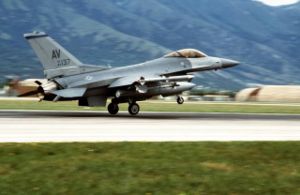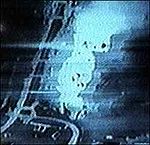- 1995 NATO bombing campaign in Bosnia and Herzegovina
-
This article is about the NATO bombing campaign in August and September 1995. For NATO bombings in 1994 and the rest of 1995, see Operation Deny Flight.
Operation Deliberate Force Part of NATO intervention in Bosnia
A US Air Force F-16C Fighting Falcon aircraft returns to Aviano AB, Italy, from a mission in support of NATO airstrikes against Republika SrpskaDate 30 August - 20 September 1995 Location Republika Srpska in Bosnia and Herzegovina Result Starting of the finalization of the Bosnian War - Siege of Sarajevo lifted.
- Bosnian Serbs return to negotiations
Belligerents  NATO
NATO Republika Srpska
Republika SrpskaCommanders and leaders 
 Leighton W. Smith
Leighton W. Smith

 Michael E. Ryan
Michael E. Ryan

 Dick Applegate
Dick Applegate Ratko Mladić
Ratko MladićStrength ~400 aircrafts[1]
5,000 personnel~80,000 men[2] Casualties and losses 1 Mirage 2000 shot down[3]
2 pilots POW[3]Caused by NATO:
25-27 persons killed[4][5]
Total casualties in September, 1995:
1,156 soldiers killed
372 civilians killeda [6]a Maritime Monitor – Sky Monitor – Maritime Guard – Deny Flight – Sharp Guard – Deliberate Force – IFOR – SFORThe 1995 NATO bombing in Bosnia and Herzegovina (code-named by NATO Operation Deliberate Force) was a sustained air campaign conducted by the North-Atlantic Treaty Organization to undermine the military capability of the Army of the Republika Srpska (Vojska Republike Srpske, VRS) which threatened and attacked UN-designated "safe areas" in Bosnia during the Bosnian war. The operation was carried out between 30 August and 20 September 1995, involving 400 aircrafts and 5,000 personnel from 15 nations. The operation was commanded by Admiral Leighton W. Smith.[7]
Contents
Background
On 4 June 1993 the United Nations Security Council passed Resolution 836 authorized the use of force by UNPROFOR in the protection of specially designated safe zones.[8] On 15 June 1993, Operation Sharp Guard, a naval blockade in the Adriatic Sea by NATO and the Western European Union, began after being approved at a joint session of NATO and the WEU on 8 June.[8]
On 9 February 1994, the North Atlantic Council, responding to a request by the UN Secretary General, authorised the Commander of Allied Forces Southern Europe (CINCSOUTH), U.S. Admiral Jeremy Boorda, to launch air strikes – at the request of the UN – against artillery and mortar positions in or around Sarajevo determined by UNPROFOR to be responsible for attacks against civilian targets in that city.[8][9]
On 12 March 1994, the United Nations Protection Force (UNPROFOR) made its first request for NATO air support, but close air support was not deployed, however, owing to a number of delays associated with the approval process.[10] On 10 and 11 April 1994 UNPROFOR called in air strikes to protect the Goražde safe area, resulting in the bombing of a Serbian military command outpost near Goražde by 2 American F-16 jets.[8][10][11] This was the first time in NATO's history it had ever done so.[11] This resulted in the taking of 150 U.N. personnel hostage on 14 April.[8][10] On 16 April a British Sea Harrier was shot down over Goražde by Serb forces.[11] Around 29 April a Danish contingent (Nordbat 2) on peacekeeping duty in Bosnia, as part of UNPROFOR's Nordic battalion located in Tuzla, was ambushed when trying to relieve a Swedish observation post (Tango 2) that was under heavy artillery fire by the Bosnian Serb Šekovići brigade at the village of Kalesija, but the ambush was dispersed when the UN forces retaliated with heavy fire in what would be known as Operation Bøllebank.
On 22 September 1994 NATO aircraft carried out an air strike against a Bosnian Serb tank at the request of UNPROFOR.[8][12]
After violations of the Exclusion Zones and the shelling of Safe Areas, NATO forces carried out air strikes on 25 and 26 May 1995 against Bosnian Serb ammunition depots in Pale.[8] Some 370 UN peacekeepers in Bosnia were taken hostage and subsequently used as human shields at potential targets in a bid to prevent further air strikes.[8]
On 11 July 1995, NATO aircraft attacked targets in the Srebrenica area of Bosnia-Herzegovina as identified by, and under the control of, the United Nations.[13] This was in response to Bosnian Serb forces advancing on the UN-declared Safe Area of Srebrenica.[8] On 25 July, the North Atlantic Council authorised military planning aimed at deterring an attack on the Safe Area of Gorazde, and the use of NATO air power if this Safe Area was threatened or attacked. On 1 August, the Council took similar decisions aimed at deterring attacks on the Safe Areas of Sarajevo, Bihac and Tuzla. On 4 August NATO aircraft conducted air strikes against Croatian Serb air defence radars near Udbina airfield and Knin in Croatia.[8]
Campaign
Although planned and approved by the North Atlantic Council in July 1995, the operation was triggered in direct response to the second wave of Markale massacres on 28 August 1995.
During the campaign, a total of 3515 sorties were flown against 338 individual targets. The aircraft involved in the campaign operated from Aviano Air Base, in Italy, and from the U.S. aircraft carriers USS Theodore Roosevelt and USS America. Sixty-eight percent (68%) of the ordnance used in this campaign were precision-guided munitions. The VRS integrated air defence network, comprising aircraft and surface-to-air missiles (SAMs), presented a high-threat environment to the allied air operations. A French Mirage 2000 was shot down by a Serbian shoulder-fired SAM on 30 August 1995 near Pale.[14] On the night of 10 September, the Ticonderoga class cruiser USS Normandy launched a Tomahawk missile strike from the central Adriatic Sea against a key air defense radio relay tower at Lisina, near Banja Luka.[15]
The German Luftwaffe saw action for first time since 1945 during Operation Deliberate Force.[16] Six interdictor-strike (IDS) version Tornados, equipped with infrared recce devices and escorted by 8 ECR Tornados, pinpointed Serb targets for NATO's artillery units around Sarajevo.[17][18] The artillery group was part of a Rapid Reaction Force deployed on Mount Igman to support the task of NATO's aircraft by pounding Serb artillery positions.[19] The Force was commanded by British Lieutenant General Dick Applegate.[20]
The air campaign was key to pressure on Milošević’s Yugoslavia to take part in negotiations that resulted in the Dayton Peace Agreement reached in November 1995.[21]
See also
References
- ^ Mahnken, Thomas G. (2010). Technology and the American Way of War Since 1945. New York: Columbia University Press. p. 182. ISBN 9780231123372.
- ^ Silber, Laura (1997). Yugoslavia: Death of a Nation. London: Penguin Books. p. 218. ISBN 9780140262636.
- ^ a b Shot-down French pilots `held captive' The Independent, 19 September 1995
- ^ Robert C. Owen (January 2000). "Deliberate Force A Case Study in Effective Air Campaigning. Final Report of the Air University Balkans Air Campaign Study". Air University Press. p. 522. http://www.au.af.mil/au/awc/awcgate/au/owen.pdf.
- ^ Robert C. Owen (30 September 2011). "Operation Deliberate Force: A case study in humanitarian constrains in aerospace warfare". Harvard Kennedy School. p. 63. http://www.hks.harvard.edu/cchrp/Web%20Working%20Papers/Owen2001.pdf.
- ^ Research and Documentation Center (RDC)
- ^ Holbrooke, Richard (1999). To End a War. New York: Modern Library. p. 327. ISBN 0-375-75360-5. OCLC 40545454.
- ^ a b c d e f g h i j NATO Handbook: Evolution of the Conflict, NATO, http://www.nato.int/docu/handbook/2001/hb050102.htm
- ^ Carnes, Mark Christopher (2005). American national biography. 29. Oxford University Press. p. 29. http://books.google.com/books?id=wZczV8ZxgL4C&pg=PA29.
- ^ a b c Report A/54/549, Report of the Secretary-General pursuant to General Assembly resolution 53/35: The fall of Srebrenica
- ^ a b c Bethlehem, Daniel L.; Weller, Marc (1997). The 'Yugoslav' Crisis in International Law. Cambridge International Documents Series. 5. Cambridge University Press. p. liiv. ISBN 9780521463041. http://books.google.com/books?id=7SczBzxA6-IC&pg=PR54.
- ^ "NATO AIRCRAFT ATTACK BOSNIAN-SERB TANK" (in English) (Press release). NATO. 22 September 1994. http://www.nato.int/docu/pr/1994/p94-090.htm.
- ^ "NATO AIRCRAFT PROVIDE CLOSE AIR SUPPORT IN THE SREBRENICA AREA" (in English,Français) (Press release). NATO. 11 July 1995. http://www.nato.int/docu/pr/1995/p95-068.htm.
- ^ Central Intelligence Agency. (2002). Balkan battlegrounds: a military history of the Yugoslav conflict, 1990-1995. Central Intelligence Agency, Office of Russian and European Analysis, v. 1, page 378
- ^ Rip, Michael Russell and Hasik, James M. (2002) The Precision Revolution: GPS and the Future of Aerial Warfare. Naval Institute Press, p. 226. ISBN 1-55750-973-5
- ^ The Victoria Advocate, 2 September 1995
- ^ Owen, Robert (2000). Deliberate Force: a case study in effective air campaigning. DIANE Publishing, p. 246. ISBN 1-58566-076-0
- ^ Trevor, Findlay (1996). Challenges for the new peacekeepers. Oxford University Press, p. 41. ISBN 0-19-829199-X
- ^ Franke, Volke (2005). Terrorism and peacekeeping: new security challenges. Greenwood Publishing Group, p. 47. ISBN 0-275-97646-7
- ^ Jane's Conferences-UK Defence Conference 2007
- ^ Holbrooke, Richard (1999). To End a War. New York: Modern Library. p. 102. ISBN 0-375-75360-5. OCLC 40545454.
External links
- Operation Deliberate Force fact sheet, NATO website, updated 16 December 2002.
- "Operation Deliberate Force," Globalsecurity.org.
- "Aircraft Carrier USS America Replaces USS Roosevelt in Adriatic," 12 September 1995, CNN.
- "Louder Than Words," TIME magazine, September 11, 1995.
- "If U.S. Force Is Needed In Bosnia," by Michael Johns, The Christian Science Monitor, 25 February 1994.
Bosnian War Timeline 19911992 Serbian Republic of Bosnia and Herzegovina ·
Serbian Republic of Bosnia and Herzegovina ·  Republic of Bosnia and Herzegovina · Siege of Sarajevo · Siege of Bihać · Graz agreement · Croat–Bosniak War · Operation Vrbas '92 · Operation Corridor1993Kravica attack · Siege of Gornji Vakuf · Siege of Mostar · Operation Neretva '93 ·
Republic of Bosnia and Herzegovina · Siege of Sarajevo · Siege of Bihać · Graz agreement · Croat–Bosniak War · Operation Vrbas '92 · Operation Corridor1993Kravica attack · Siege of Gornji Vakuf · Siege of Mostar · Operation Neretva '93 · Autonomous Province of Western Bosnia · Operation Deny Flight19941995Mrkonjić Grad incident · Operations Krivaja '95 and Stupčanica '95 · Operation Summer '95 · Operation Storm · 1995 NATO bombing campaign in Bosnia and Herzegovina · Operation Mistral · Operation Sana · Dayton Agreement ·
Autonomous Province of Western Bosnia · Operation Deny Flight19941995Mrkonjić Grad incident · Operations Krivaja '95 and Stupčanica '95 · Operation Summer '95 · Operation Storm · 1995 NATO bombing campaign in Bosnia and Herzegovina · Operation Mistral · Operation Sana · Dayton Agreement · Bosnia and Herzegovina
Bosnia and HerzegovinaWar Crimes Ethnic cleansingAhatovići · Ahmići · Bijeljina · Biljani · Čemerno · Doboj · Dobrinja · Doljani · Duša · Foča · Glogova · Grabovica · Kiseljak · Korićani Cliffs · Kravica · Lašva Valley · Makljen · Markale · Mokronoge · Prijedor · Prozor · Raštani · Srebrenica · Stolac · Stupni Do · Štrpci · Tuzla · Višegrad (Barimo, Bosanska Jagodina, Paklenik, Sjeverin) · Vlasenica · Vrbanja · Zaklopača · ZvornikCampsCasesCategories:- Conflicts in 1995
- Military operations involving NATO
- Military operations involving Germany
- Bosnian War
- Aerial bombing operations and battles
- Military operations of the War in Bosnia and Herzegovina
- Siege of Sarajevo lifted.
Wikimedia Foundation. 2010.


